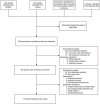Efficacy of home-based non-pharmacological interventions for treating depression: a systematic review and network meta-analysis of randomised controlled trials
- PMID: 28706086
- PMCID: PMC5734422
- DOI: 10.1136/bmjopen-2016-014499
Efficacy of home-based non-pharmacological interventions for treating depression: a systematic review and network meta-analysis of randomised controlled trials
Abstract
Objectives: To systematically review and compare the efficacy of all available home-based non-pharmacological treatments of depression.
Design: Systematic review and network meta-analysis of randomised controlled trials.
Data sources: Medline, Scopus and Cumulative Index to Nursing and Allied Health Literature (CINAHL) databases were searched since inceptions to 7 August 2016.
Eligibility criteria: Randomised controlled trials comparing the efficacy of home-based non-pharmacological interventions with usual care of patients with depression were included in the review.
Main outcomes: Depression symptom scores and disease remission rates at the end of treatment.
Results: Seventeen studies were included in the review. Home-based non-pharmacological interventions were categorised as (1) home-based psychological intervention, (2) home-based exercise intervention, (3) combined home-based psychological intervention with exercise intervention and (4) complementary medicine. Complementary medicine approaches were excluded from the meta-analysis due to heterogeneity. The standardised mean differences of post-treatment depression symptom scores between usual care groups and home-based psychological intervention, home-based exercise intervention and combined home-based psychological intervention with exercise intervention were âˆ'0.57 (95% CI âˆ'0.84 to âˆ'0.31), âˆ'1.03 (95% CI âˆ'2.89 to 0.82) and âˆ'0.78 (95% CI âˆ'1.09 to âˆ'0.47), respectively. These results suggest that only home-based psychological intervention and combined home-based psychological intervention with exercise intervention could significantly decrease depression scores. Compared with usual care groups, the disease remission rate was also significantly higher for home-based psychological intervention (pooled risk ratio=1.53; 95% CI 1.19 to 1.98) and combined home-based psychological intervention with exercise intervention (pooled risk ratio=3.47; 95% CI 2.11 to 5.70). Of all the studied interventions, combined home-based psychological intervention with exercise intervention had the highest probability of resulting in disease remission.
Conclusion: Our study confirms the efficacy of home-based psychological intervention and combined home-based psychological intervention with exercise intervention in the treatment of depression. Combined home-based psychological intervention and exercise intervention was the best treatment and should be considered for inclusion in clinical guidelines for managing depression.
Keywords: depression; home-based intervention; network meta-analysis; systematic review; treatment.
© Article author(s) (or their employer(s) unless otherwise stated in the text of the article) 2017. All rights reserved. No commercial use is permitted unless otherwise expressly granted.
Conflict of interest statement
Competing interests: All authors have completed the ICMJE uniform disclosure form at www.icmje.org/coi_disclosure.pdf and declare no support from any organisation for the submitted work, no financial relationships with any organisations that might have an interest in the submitted work in the previous three years and no other relationships or activities that could appear to have influenced the submitted work.
Figures
References
-
- Rovner BW, German PS, Brant LJ, et al. . Depression and mortality in nursing homes. JAMA 1991;265:993–6. - PubMed
-
- Unützer J, Katon W, Callahan CM, et al. . Collaborative care management of late-life depression in the primary care setting: a randomized controlled trial. JAMA 2002;288:2836–45. - PubMed
Publication types
MeSH terms
LinkOut - more resources
Full Text Sources
Other Literature Sources
Medical


